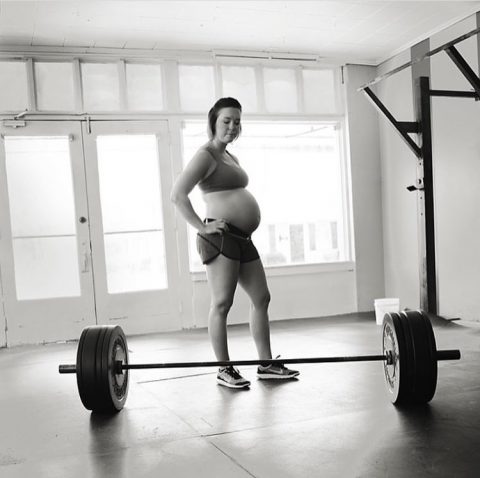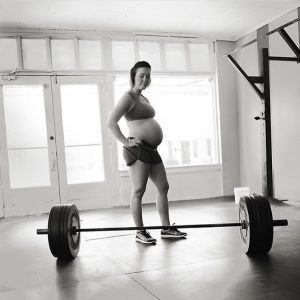
During the first trimester visit, many medical practitioners will tell pregnant women not to lift more than 15 lbs until 6 weeks after the birth of their baby (maybe). I truly believe these practitioners are doing what they think is best, but unfortunately, they are missing the mark for the vast majority of women under their care.
The positive intention here is that there are a handful of women who should not be lifting more than 15 lbs due to an impeding medical condition. I also believe there are a handful of women who do not have sound movement patterns and lifting more than 15 lbs resulted in a preventable injury (prevention being the right coaching not necessarily the lifting itself). So, to reach the widest audience with medical advice, practitioners speak to the lowest common denominator and continue to recommend not lifting more than 15 lbs during pregnancy.
 I’m Melissa Hemphill, BIRTHFIT Regional Director in Colorado. I have 3 beautiful children of my own and have been told with every pregnancy not to lift more than 15 lbs. And with every pregnancy, I chose to listen to my body instead.
I’m Melissa Hemphill, BIRTHFIT Regional Director in Colorado. I have 3 beautiful children of my own and have been told with every pregnancy not to lift more than 15 lbs. And with every pregnancy, I chose to listen to my body instead.
This was not a rogue decision. The scientific data* to support exercise during pregnancy is substantial. The biggest issue I see in this dilemma is the lack of personalized care in our healthcare system. If practitioners started asking about lifestyle habits—What do you do for fitness? How long have you been doing this? How often do you practice? What sort of percent of your 1 rep max deadlift is 15 lbs? How well do you rest and nourish yourself?—we could tailor medical advice to fit the woman and set her up for the best possible pregnancy, birth, and postpartum.
Pregnancy and Fitness. What’s the Difference?
The physiology of pregnancy amazes me. Did you know that the exact same adaptations happen to a woman who becomes pregnant as with a person who begins a fitness program? Here are a few examples:
- Increased blood volume (to baby/ muscles)
- Increased heart chamber volumes (to accommodate increased blood volume)
- Increased maximal cardiac output/ stroke volume
- Blood vessel growth (to accommodate blood volume and deliver nutrients more efficiently)
- Ability to dissipate heat more efficiency (at lower temperatures) – pregnant women have a +1°F basal temp increase for optimal immune function and metabolism
- Increased delivery of oxygen and nutrients to the tissues (to baby)
- Increased oxygen availability and usage at cellular level (to make more ATP-cellular currency-to grow a baby)
- Increased metabolic capacity, insulin sensitivity, muscle mass, and the use of fat stores to supply energy requirements
- Reduces stress response to exercise (adaptation to stimuli)
- Improves most, if not all, aspects of musculoskeletal function and its effects on bone (i.e. bone density)
When a trained pregnant woman continues to train during her pregnancy, the results are at least additive if not greater! Pregnancy and birth calls on women to be fit. Their motherhood and life experience requires it.
Dr. James Clapp has performed numerous studies on the effects of exercise and pregnancy and found many benefits for both mom and baby. Unfortunately, his book, Exercising Through your Pregnancy, did not enter the mainstream.
Mom Gainz
- Does NOT increase the incidence of either miscarriage or birth defects
- Decreases the chances of premature labor and the birth of a very small baby
- Decreases weight gain and fat deposition
- Decreases physical discomforts, hastens recovery
- Tend to have easier, shorter, and less complicated labors
- Positive attitudes about themselves/ their body/ future
- Improved immune function
- Higher energy levels
Baby Gainz
- Decreases fetal fat without decreasing overall growth
- Smooth transition to life outside the womb and increased ability to self-sooth
- Sound and vibratory stimuli before birth can accelerate the development of baby’s brain
- All aspects of growth and development after birth are as good as or better than babies from non-exercising moms
A fitter mom literally means a fitter baby. So let’s talk about how we achieve this in a smart, safe way. BIRTHFIT is an empowered, educated state of readiness—specific to childbirth—that is achieved through an evolved practice in fitness, nutrition, chiropractic, and mindset. With prenatal fitness, we are not trying to be CrossFit Games athletes at 40 weeks, we are intentionally training for birth.
Labor requires all three main metabolic pathways: Creatine-Phosphate, Glycolysis, and Aerobic Respiration. Training in a way that is varied and stimulates each of these pathways is key. During this time, it’s also smart to avoid certain activities like poor posture, abdominal flexion (sit ups, crunches, GHD sit ups, toes to bar, etc), kipping/ butterfly pull ups, and lifts greater than 80% of your 1 rep max. For monitoring, YOU are the best indicator, not a heart rate monitor. Everyone’s heart rate is unique to them based on their genetics and lifestyle habits.
Pregnancy is the time to foster trust with your body. Some days you may feel like superwoman and other days you may struggle to get out of bed. Your body is wise beyond words and learning to listen to your body’s needs is part of this training! BIRTHFIT recommends keeping a journal that captures how you feel each day, your basal body temperature, and how much fetal movement you feel 30 minutes post-workout. Notice patterns that are unique to you. During pregnancy, your body prioritizes resources to baby. You will be cued to slow down or stop long before baby is affected. Again, the mindset piece here is building trust with your body. Listen to those cues.
Fitness is allowed to be difficult as long as it enhances your overall wellbeing. Difficulty recovering, extreme fatigue, illness, and pain are all signs that it was too much. Take the rest you need, apply your body’s feedback, and try again next time. If you have any questions or would like to see if BIRTHFIT is in your area, please do not hesitate to contact me! We are a tribe and we will support you.
*Sources:
- Clapp JF 3rd. The effects of maternal exercise on early pregnancy outcome. Am J Obstet Gynecol 1989;161:14.
- Hatch MC, Stein ZA. Work and exercise during pregnancy: epidemiological studies, in Artal R, Wiswell RA, Drinkwater BL (eds). Exercise in pregnancy, ed 2. Baltimore: Williams & Wilkins 1991, pp. 279-86.
- Clapp JF 3rd. The course of labor after endurance exercise during pregnancy. Am J Obstet Gynecol 1990;163:1799-805.
- Clapp JF 3rd. Exercising Through Your Pregnancy. Champaign, Ill: Human Kinetics Publishers Inc; 1998, pp. 145-51.
- Tahir S, Aleem M, Aziz R. Incidence and outcome of preterm-premature rupture of membranes. Pak J Med Sci 2002;18:26-32.
- Beckmann CR, Beckmann CA. Effect of a structured antepartum exercise program on pregnancy and labor outcome in primiparas. J Reprod Med 1990;35:704-9.
- Clapp JF 3rd. Cover story: recommending exercise during pregnancy. Contemporary Obstet Gynaecol 2001;1:30-49.
- Clapp JF 3rd, Kim H, Burciu B, et al. Continuing regular exercise during pregnancy: effect of exercise volume on fetoplacental growth. Am J Obstet Gynecol 2002;186:142-7.


0 Comments